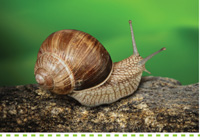What are snail and slug symptoms?
Snails and slugs are both molluscs and are voracious easers of a wide variety of plant life in the garden. Snails have a distinctive shell on their back while slugs do not. Both are capable of climbing large shrubs and small plants alike. The European snail is the most commonly found in gardens, while there are many varied native species of snails. All snails and slugs (however irritating) have an important role to play in healthy ecologies.
Recognising snail and slug activity
Snail and slug activity is easy to spot by the silver slim trail they both leave behind as they feed. They are night time feeders and rarely emerge during the day to feed unless continual wet weather is prominent and days are overcast. During the day they hide under rock crevices, pots and anywhere dry. Large leaves will have holes effected by their rasping habits and young seedlings will often be eaten to ground level with nothing remaining.
How to Control snail and slugs
Avoid watering late in the afternoon as this provides moist superhighways for them to travel with great ease through plants and along pathways. Bury jars or small buckets in the garden and fill with beer as they are attracted to the yeast content and will drown in the liquid. Use course, sharp grit or coffee grounds to protect young seedlings as they cannot cross these to feed. Registered ( non-toxic and pet friendly ) pellets are also widely offered . Encourage strong predators such as lizards and birds for natural predation.
Control snails and slugs with Searles Snail & Slug Pellets. These pellets contain the most bitter substance known to man, to act as a taste deterrent to discourage consumption by children and to a lesser extent, pets.

|

